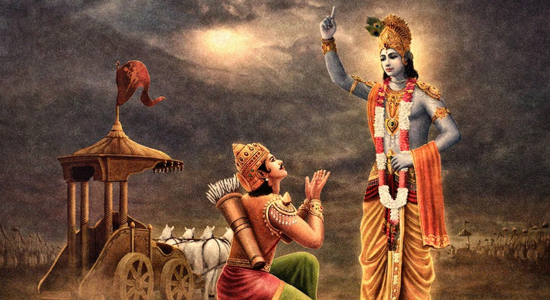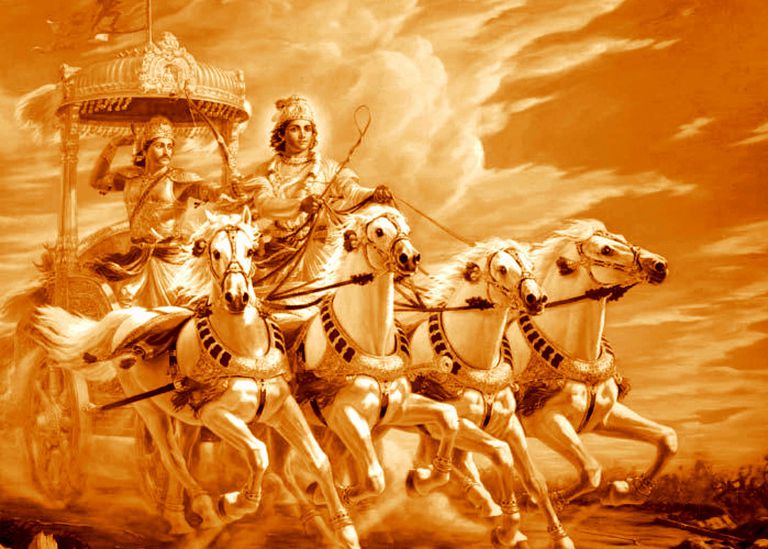This is a new series on Bhagavad Gita as I re-read it again. In this series, I will be sharing verses from Bhagavad Gita in its original order as I read, from the Chapter 1 onwards…
As we know, Bhagavad Gita is one of the greatest and most profound books ever written and it is truly a gift to the humanity by Sanatana Dharma / Hinduism! Known as the “Song of God”, it is part of a larger ancient Hindu epic, Mahabharata.
Bhagavad Gita has been translated into more than 75 languages so far and counting. In English alone, there has been over 300 translations! It has 700 verses and it appears in the 6th book of Mahabharata, from Chapter 23 to 40.
One would wonder how a single book could have so many translations and interpretations! It is believed that the meaning of the Gita varies from person to person, based on their own experiences with life. From a kid to a grown up man, the Gita offers nothing but unlimited wisdom that can transform one’s life forever! No wonder, why there are so many leadership talks based on the Gita going around now!
It is truly sad that the Gita isn’t widely read in India, a land that gifted so much knowledge and wisdom to this entire world! When I first read the Gita, I was going through a massive depression. Almost at the same time, I also had an opportunity to attend the Bhagavad Gita discourses conducted by Chinmaya Mission, Chennai. The discourse was on chapter 1 and 2 and trust me, my whole life was completely transformed. It changed the way I looked at myself and experience the world around me! It not only helped me deal with my depression and to embracing my life truly the way it is, but also helped me look at the world around me from a completely new perspective! I am forever grateful to Chinmaya Mission, Chennai, and their great Gurus!
All the translations and some commentary you would read here in this series is based on the book Bhagavad Gita As It Is by Shri A.C. Bhaktivedanta Swami Prabhupada, founder of the International Society for Krishna Consciousness (ISKCON) and the Hare Krishna Movement.
Most people don’t seem to read the Gita because of their confusion about where to start, given there are so many variations that are available! Exactly why I love Bhagavad Gita As It Is, because, in this, Swami Prabhupada beautifully outlines the original verses from the Gita, their word to word meaning from Sanskrit to English, the English translation and detailed commentary on those verses. Because it is written with so much devotion, knowledge, love and respect, anyone can read the Gita and understand its meaning in their own capacity.
There are obviously some things in the commentary from Bhagavad Gita As It Is I do not resonate with. You too may feel the same way about some of the commentaries and that is absolutely okay! I am not a person to ask anyone to follow anything blindly – that is not what our great traditions are meant for either – follow only the things that make sense to you!
You would come across many people talking about various rules and mantras to chant before reading the Gita. I am not saying, there aren’t any rules, but I would suggest that you please do not to worry about any such things, but read the Gita with devotion! Forget about the rules and mantras and whatever else that may stop you from making an attempt to read the Gita! All you have to do is to just read the Gita with devotion or at least with an open mind! We need more people to read this pearl of wisdom and spread it to the world! Once you read the Gita, you would feel like re-reading it again and again and then onwards, you would try to seek out for more meaningful ways to read and understand this holy text. But not to worry about that for now.
There is no point in reading the Gita in a language you don’t understand – for example, if you do not know Sanskrit, there is no point in parroting the Gita verses in Sanskrit without understanding its meaning. Read it in a language you understand.
In Lord Krishna’s own words,
Gita Chapter 2 – 70
adhyeṣyate ca ya imaṁ
dharmyaṁ saṁvādam āvayoḥ
jñāna-yajñena tenāham
iṣṭaḥ syām iti me matiḥ
And I [Lord Krishna] declare that he who studies this sacred conversation of ours worships Me by his intelligence
Gita Chapter 2 – 71
śraddhāvān anasūyaś ca
śṛṇuyād api yo naraḥ
so ’pi muktaḥ śubhāḻ lokān
prāpnuyāt puṇya-karmaṇām
And one who listens with faith and without envy becomes free from sinful reactions and attains to the auspicious planets where the pious dwell.
Aum Namo Bhagavate Vasudevaya
Aum Namo Bhagavate Vasudevaya
Aum Namo Bhagavate Vasudevaya
Gurur Brahma Gurur Vishnu Gurur Devo Maheshwaraha
Guru Saakshaat Para Brahma Tasmai Sri Gurave Namaha
Om Shanti Shanti Shanti

The Story Behind the Bhagavad Gita
The Mahabharata is one of the greatest epics of Hinduism / Sanatana Dharma. Mahabharata talks about the story of many generations of Kuru dynasty who ruled the Kuru Kingdom. The central part of this epic is an account of conflict between the two rival families belonging to Kuru clan which led to the greatest of the wars ever fought, the Mahabharata War, also known as the Kurukshetra war. The following is a very very short story that led to the Bhagavad Gita.
Sage Vyasa had three sons – Dhritarashtra, Pandu and Vidura. Vidura learned all the vedas and scriptures and became a learned man of great wisdom and integrity. Where as, Dhritarashtra and Pandu were trained in warcraft, archery, fighting, etc. All three of them were very well taken care by their uncle, Bhishma. While these boys were young and not ready to rule the kingdom, Bhishma ruled the capital, Hastinapura.
Dhritarashtra was the eldest, however, he was blind. Thus, he was not fit to be the king. That led to Pandu being chosen to take over the throne and became the king. This obviously was a bitter pill to swallow for Dhritarashtra. That was the start of their rivalry.
Dhritarashtra eventually had 100 sons born to Gandhari and another son, Yuyutsu, born to a servant named Sukhada, making the whole of Kauravas to 101 sons.
On the other hand, Pandu married Kunti and Madri and had 3 sons with Kunti and two with Madri. Yudhisthira, Bhima and Arjuna were born to Kunti while Nakula and Sahadeva were born to Madri.
Kuru kingdom was divided into two, of which, the part where Hastinapura as the capital was ruled by Dhritarashtra, of the Kauravas. The other part where Indraprastha as the capital was ruled by Yudhishthira, of the Pandavas. Due to the rivalry between these two families – the Kauravas and the Pandavas – Kauravas resorted to cheating, deception, poisoning and all kinds of ways to defeat and to capture the areas ruled by Pandavas at various point in time. Eventually, Yudhisthira lost his kingdom in a game of dice where he was cheated. Along with his kingdom, he also lost all his brothers and his wife, Draupadi, in the game of dice. They were all asked to go into exile in the forests for 13 years.
Duryodhana refused to restore Pandavas their kingdom, Indraprastha, after the 13 years of exile, which was promised at the beginning of their exile. Even after many attempts to diplomatically solve this dispute and even with the involvement of Lord Krishna as the mediator, Duryodhana refused to give the Pandavas their due, or even a single house to stay the least. The Pandavas were left with no choice, but to go to a fully fledged war with the Kauravas to restore what was rightfully theirs and to uphold Dharma.
The Kurukshetra war took place at Kurukshetra which is also called Dharmakshetra – the field of Dharma. It is believed that any sins committed at Kurukshetra is immediately forgiven because of the sanctity of this land.
Before the war, both Duryodhana and Arjuna went to Lord Krishna to seek help. The ever boastful Duryodhana went and sat near the head of Lord Krishna while the ever respectful, obedient disciple, Arjuna, sat at the feet of the Lord. When Lord Krishna woke from his sleep and gave them two options – one would get his Army, the Narayani Sena, and the other could choose Lord Krishna himself. Since Lord Krishna saw Arjuna first the moment he woke up from his sleep, he gave Arjuna the option to choose first. Arjuna chose to have Lord Krishna at his side. The greedy Duryodhana was happy and chose Lord Krishna’s army. Thus Lord Krishna became the charioteer to his intimate friend and disciple, Arjuna, getting the name, Parthasaradhi.
At the battlefield of Kurukshetra, Arjuna looks at the opponents and recognises his friends, gurus, relatives including his Grandsire, Bhishma, etc. in the opposing army, and tells himself that it doesn’t worth fighting against all of those people who are his blood relations and gurus, simply to get back their kingdom. Emotionally broke down, Arjuna drops his bows and arrows and decides to quit from the battlefield.
Lord Krishna, Arjuna’s charioteer, sees this and persuades him to stick to his duty as a warrior, as a Kshatriya, and to engage his enemies, the Kauravas. This is where the Bhagavad Gita begins, as a conversation between the Lord and his disciple, the seeker and the sought, the knower and the known, in the Kurukshetra battlefield.
See you in the Part 2 soon…

